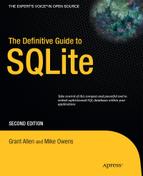Contents
SQLite's Features and Philosophy
Getting the Command-Line Program
Compiling the SQLite Source Code on Windows
Building the SQLite DLL with Microsoft Visual C++
Building a Dynamically Linked SQLite Client with Visual C++
SQLite on Linux, Mac OS X, and Other POSIX Systems
Getting Database Schema Information
Performing Unattended Maintenance
Getting Database File Information
select and the Operational Pipeline
![]() Chapter 4: Advanced SQL for SQLite
Chapter 4: Advanced SQL for SQLite
![]() Chapter 5: SQLite Design and Concepts
Chapter 5: SQLite Design and Concepts
Creating User-Defined Functions
Creating User-Defined Aggregates
Creating User-Defined Collations
![]() Chapter 7: The Extension C API
Chapter 7: The Extension C API
![]() Chapter 8: Language Extensions
Chapter 8: Language Extensions
APSW as an Alternative Python Interface
User-Defined Functions and Aggregates
User-Defined Functions and Aggregates
![]() Chapter 9: iOS Development with SQLite
Chapter 9: iOS Development with SQLite
Prerequisites for SQLite iOS Development
Signing Up for Apple Developer
Downloading and Installing Xcode and the iOS SDK
Building the iSeinfeld iOS SQLite Application
Step 1: Creating a New Xcode Project
Step 2: Adding the SQLite Framework to Your Project
Step 3: Preparing the Foods Database
Step 4: Creating Classes for the Food Data
Step 5: Accessing and Querying the SQLite DB
Step 6: Final Polish and Wiring for iSeinfeld
Working with Large SQLite Databases Under iOS
![]() Chapter 10: Android Development with SQLite
Chapter 10: Android Development with SQLite
Prerequisites for SQLite Android Development
Check Prerequisites and the JDK
Downloading and Installing the Android SDK Starter Package
Downloading and Installing the Android Developer Tools
Adding Android Platforms and Components
The Android SQLite Classes and Interfaces
Using the Basic Helper Class, SQLiteOpenHelper
Working with the SQLiteDatabase Class
Applying SQLiteOpenHelper and SQLiteDatabase in Practice
Querying SQLite with SQLiteQueryBuilder
Building the Seinfeld Android SQLite Application
Creating a New Android Project
Adding the Seinfeld SQLite Database to Your Project
Linking the Data and User Interface
Viewing the Finished Seinfeld Application
Care and Feeding for SQLite Android Applications
Working with Large SQLite Databases Under Android
![]() Chapter 11: SQLite Internals and New Features
Chapter 11: SQLite Internals and New Features
Manifest Typing, Storage Classes, and Affinity
Activation and Configuration WAL
WAL Advantages and Disadvantages
